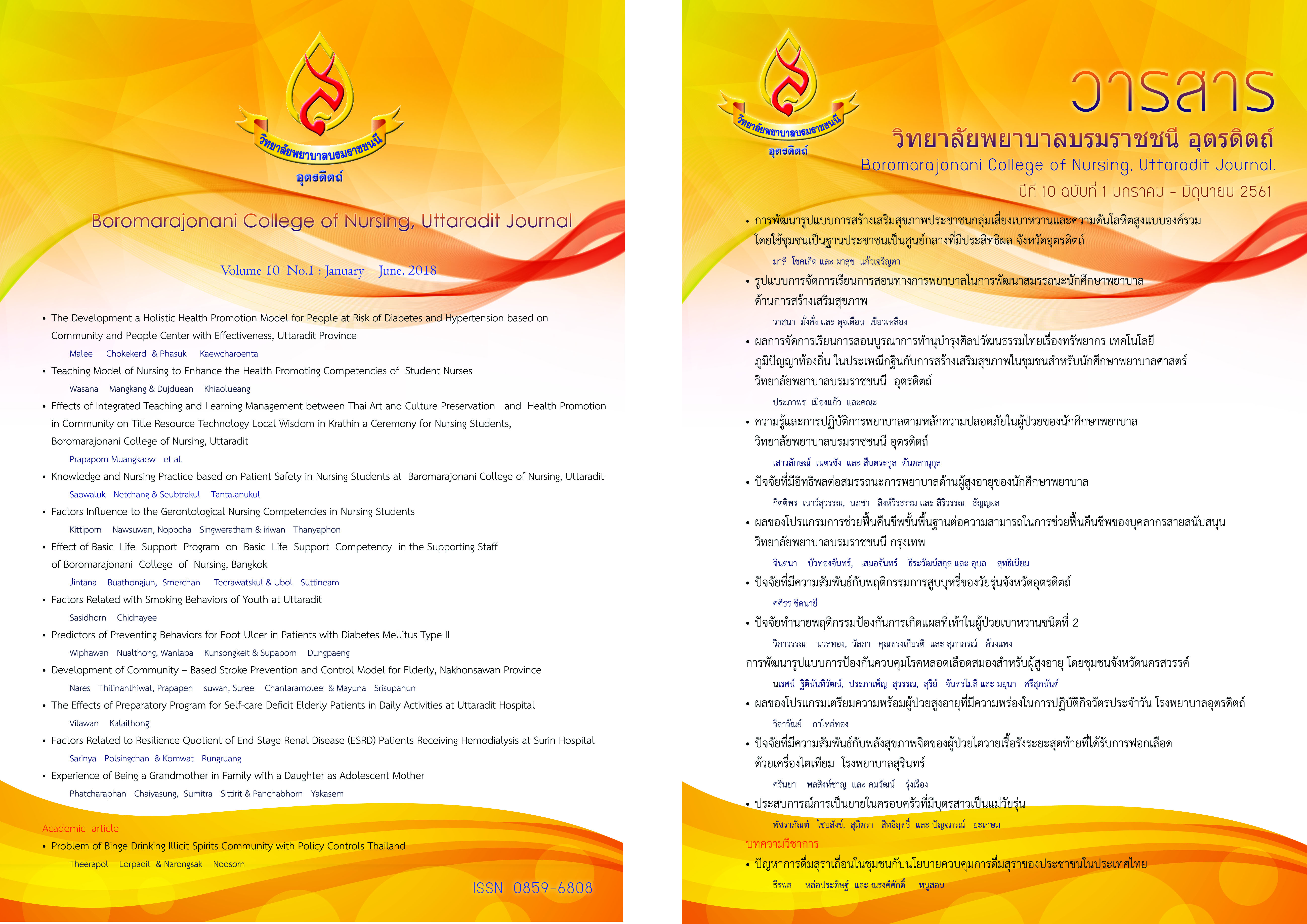ผลของโปรแกรมการช่วยฟื้นคืนชีพขั้นพื้นฐานต่อความสามารถในการช่วยฟื้นคืนชีพของบุคลากรสายสนับสนุนวิทยาลัยพยาบาลบรมราชชนนี กรุงเทพ
Main Article Content
บทคัดย่อ
การวิจัยกึ่งทดลองนี้ มีวัตถุประสงค์เพื่อ เปรียบเทียบความรู้และทักษะก่อนและหลังได้รับโปรแกรมการช่วยฟื้นคืนชีพขั้นพื้นฐาน กลุ่มตัวอย่าง คือ บุคลากรสายสนับสนุนจำนวน 40 ราย กลุ่มตัวอย่างจะได้รับโปรแกรมที่ประกอบด้วย การทดสอบความรู้การช่วยฟื้นคืนชีพขั้นพื้นฐาน จำนวน 3 ครั้ง คือ ก่อนเข้าร่วมโปรแกรม หลังเข้าร่วมโปรแกรมทันที และภายหลังเข้าร่วมโปรแกรม 3 เดือน กลุ่มตัวอย่างจะได้รับฟังการบรรยายและการสาธิตวิธีการช่วยฟื้นคืนชีพขั้นพื้นฐาน 45 นาทีกลุ่มตัวอย่างฝึกทักษะทุกคนๆละ 5 นาที เมื่อครบทุกคน ผู้วิจัยทดสอบทักษะกลุ่มตัวอย่างโดยใช้สถานการณ์จำลองและติดตามความคงอยู่ของความรู้และทักษะหลังเข้าร่วมโปรแกรม 3 เดือน เครื่องมือเก็บรวบรวมข้อมูล ได้แก่ แบบสอบถามข้อมูลส่วนบุคคล แบบวัดความรู้และแบบประเมินทักษะ สถิติในการวิเคราะห์ข้อมูล ได้แก่ ค่าเฉลี่ย ส่วนเบี่ยงเบนมาตรฐาน และวิเคราะห์ความแปรปรวนแบบวัดซ้ำ (Repeated measure oneway ANOVA) ผลการศึกษาพบว่า ความรู้การช่วยฟื้นคืนชีพขั้นพื้นฐานกลุ่มทดลองภายหลังได้รับโปรแกรมมากกว่าค่าเฉลี่ยก่อนได้รับโปรแกรมอย่างมีนัยสำคัญทางสถิติที่ระดับ .05 ทักษะการช่วยฟื้นคืนชีพขั้นพื้นฐานกลุ่มทดลองภายหลังสิ้นสุดการให้โปรแกรมทันทีมากกว่าค่าเฉลี่ยคะแนนทักษะการช่วยฟื้นคืนชีพขั้นพื้นฐานภายหลังได้รับโปรแกรม 3 เดือนอย่างไม่มีนัยสำคัญทางสถิติที่ระดับ.05
Article Details
บทความหรือข้อคิดเห็นใดใดที่ปรากฏในวารสารวิจัยการพยาบาลและวิทยาศาสตร์สุขภาพ เป็นวรรณกรรมของผู้เขียน ซึ่งบรรณาธิการหรือสมาคมศิษย์เก่า ไม่จำเป็นต้องเห็นด้วย และบทความที่ได้รับการตีพิมพ์เผยแพร่ถือเป็นลิขสิทธิ์ของวารสารวิจัยการพยาบาลและวิทยาศาสตร์สุขภาพ
เอกสารอ้างอิง
2. Berg, R. A., Hemphill, R., Abella, B. S., et al. (2010). Part 5: Adult basic life support. In M. F. Hazinski&J. M. Field (Eds.) 2010American Heart Association Guidelines for Cardiopulmonary Resuscitation and Emergency Cardiovascular Care.Circulation, 122, 18(Supplement 3), S685-S705.
3. Best, J. W. & Kahn, J. V.(2006). Research in education. Boston: Allyn and Bacon.
4. Hollenberg, J., Herlitz, J., Lindqvist, J., Riva, G., Bohm, K., Rosenqvist, M., &Svensson, L. (2008).Improved survival after out-of-hospital cardiac arrest is associated with an increase in proportion of emergency crew--witnessed cases and bystander cardiopulmonary resuscitation. Circulation, 118(4), 389-396. doi:10.1161/CIRCULATIONAHA.107.734137
5. Kusoom, W. (2003). CPR. Bangkok: Borpit Printing.
6. McNally, B., Robb, R., Mehta, M., Vellano, K., Valderrama, A. L., & Yoon, P. W. (2010). Out-of-Hospital Cardiac Arrest Surveillance --- Cardiac Arrest Registry to Enhance Survival (CARES), United States, October 1, 2005--December 31, 2010. Centers for Disease Controll and Prevention, 60, 1-19.
7. Puttichot, K., Wanwimolsuk, K., &Boonsiri, C. (2009). Cardiopulmonaryresuscitation at emergency department, BhumibolAdulyadej Hospital. Royal Thai Air Force Medical Gazette, 55, 39.
8. Seangnhern, U., Uppanisakorn, S., Chinnawong T. (2012). Factors related to nurses’ knowledge and skills in cardiopulmonary resuscitation in Songklanagarind Hospital. Songkhlanagarind Journal of Nursing, 32(1), 1-10.
9. Steinmetz, J., Barnung, S., Nielsen, S. L., Risom, M., & Rasmussen, L. S. (2008). Improved survival after an out-of-hospital cardiac arrest using new guidelines. ActaAnaesthesiologicaScandinavica, 52(7), 908-913. doi:10.1111/j.1399-6576.2008.01657.x
10. Summawong, K. (2011). Development of e-learning program on basic life support for students in the Diploma of Emergency Medical Technician Program.Master of Science Thesis (Health Informatics),Ramkhamhaeng University, Bangkok.
11. Suraseranivongse, S., Chawaruechai, T., Saengsung, P., &Komoltri, C. (2006). Outcome of cardiopulmonary resuscitation in a 2300-bed hospital in a developing country. Resuscitation, 71(2), 188-193.
12. Salleeh, H. M. B., Gabralla, K. A., Leggio, W. J., & Aseri, Z. A. A. (2015). Out-of-hospital adult cardiac arrests in a university hospital in central Saudi Arabia. Saudi Medical Journal, 36(9), 1071–1075. https://doi.org/10.15537/smj.2015.9.12081
13. Vattanavanit, V., Bhurayanontachai, R., Khwannimit, B. (2013). Survival of out-of-hospital cardiac arrest patients and feasibility for therapeutic hypothermia in Songklanagarind Hospital. Songklanagarind Medical Journal, 31(6), 287-295.
14. Yeeheng, U.(2011). Factors associated with successful resuscitation of out-of-hospital cardiac arrest at Rajavithi Hospital’s Narenthorn Emergency Medical Service Center, Thailand. Asia Pacific Journal of Public Health, 23(4), 601-607. doi:10.1177/1010539511411902


